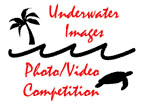Videolights
2008 U/W Competition
JUDGING
by Roger Roth
As the international, non-profit Underwater Images Photo/Video Competition comes to a close, I wanted to share with everyone how the competition fared and more importantly what the judges thought about the entries. This year, we received 50% more entries than any other year (most seemed to come in the last 2-3 weeks). The entries came from 20 different states in the United States and 25 different countries around the world.
As always, prizes are set before the judging according to the retail value of the prize donations and the number of entrants in each category. Proceeds from this competition are donated to numerous non-profit organizations that support marine conservation and preservation as well as educational scholarships. Our beneficiaries are listed on the home page of our website. (www.uwimages.org)
This year’s judges were Ned and Anna DeLoach and Eric Riesch. Ned and Anna specialize in capturing portraits of tropical marine species around the world, and are also keen students of marine life behavior. Ned is co-author with Paul Humann of numerous marine life identification books, and Reef Fish Behavior, an overview of what is currently known about the natural history of fishes of the Caribbean. Anna, a videographer, produced Sensational Seas – an anthology of underwater filmmakers, and Reef Fish Identification, a Beginning Course for REEF.
Eric Riesch is photo editor and managing director of New World Publications. For the past 15 years he has managed the cataloging, retouching and photo placement of the marine life identification books including Reef Fish Identification – Tropical Pacific which includes more than 2500 images. His photographic images have appeared in several books and magazines.
First of all, I’ll pass on what the judges had to say about this year’s competition: “In our work, we spend a lot of time underwater looking for unusual or oddball images and behaviors. Our exposure to what other underwater photographers are shooting is pretty much limited to photographs published in the mainstream dive magazines. The multitude of entries in this year’s competition offered us a dramatic insight into how significantly underwater photography has matured in recent years. The images, whether of seascapes, divers, or marine life, consistently expressed the photographers’ enlightened understanding of their subject matter. Most gratifying, the new entrants are right on track, many are only a dive trip away from distinction. Choosing winners from amongst so many excellent choices was a challenging but delightful task.”
The judging process took about 8-10 hours of their volunteered time and consisted of going through thumbnails on a large computer screen one by one in each category. In the first round, the judges quickly culled about 50% of the entries that didn’t stand out. They also paid attention to their own breathless gasps that they sometimes let out when an awesome shot came up on the computer, probably indicating that shot would end up as a finalist.Then a finer culling process took place in the next 2-4 rounds until they narrowed numbers down to about 12 in each category. This is when their job got harder and everyone discussed pros and cons of each shot more carefully. They had to decide which shots were composed better, which ones told a story, which ones were cropped better, and depths of field and focus was considered also.
Any photograph or video that ended up in the final rounds were obviously world-class quality, and choosing between them had to get picky. At this point in the judging, any or all of the shots merited winning a prize, which is why the Underwater Images board has always tried to have at least some kind of small token prize for Honorable Mention winners. (I will mention here that the judges saw a number of shots throughout the process that they would have liked to have in their own portfolios!)
Of all of the above criteria, the judges felt that improper cropping seemed to be the one thing that eliminated the highest number of entries from the competition. Some shots needed to be cropped better to get rid of unnecessary parts of the photograph. Others needed cropping to center the subject better, follow the rule of thirds more efficiently, or even to bring the subject to the forefront of the shot.
During the judging, we also discussed one of Jim Church’s favorite ways to look at slides to find the better ones. Jim used to take a filled slide page and place it on a light table upside down. Outstanding shots will jump out at the viewer, even though they are upside down.
We continued this discussion remarking that entrants could do the same thing with their own digital shots as well to choose their best shots to enter into competitions like this. All they would have to do is turn their shots 180 degrees in Photoshop, then look at a file with all the thumbnails that are now upside down.
After the judging and looking at the winners, they all discussed these shots and admitted that their preferences as this year’s judging team seemed to center around portrait and behavior shots. Interestingly enough, the Best of Show was highly contested with another first place picture for a good 15 minutes or more, and was finally awarded to “Trust” by Cor Bosman of Amsterdam, Netherland because the judges rarely, if ever see a lizardfish with its mouth that wide open; so rarity came into play on that choice.
Many shots that were entered and may not have won a prize this year were surely worthy of a prize and should be entered in this and other competitions in the future. (A fairly comprehensive list of competitions world-wide can be found on the Underwater Images website.) Entrants should keep in mind that various judging teams look for different things each time they judge competitions like this. And even the same judging team could look for something different on a different day.
The judges were surely impressed with the quality of images they viewed. For me, it was also refreshing to see some new names emerge in the winners’ list and I hope to see more of those photographers’ shots in years to come. Sea Ya!
Critter corner: When the lizardfish captures its prey, it keeps the prey in its mouth because of the many sharp teeth it has. According to Ned DeLoach in his Reef Fish Behavior book, the Engelman’s Lizardfish was found to make a strike at its prey every 35 minutes with an 11% success rate.
copyright © Roger Roth, 2002 - 2011
Roger Roth is a roofer by trade and lives in Cincinnati, Ohio. But his passion is underwater videography and after several decades of learning how to shoot and edit he has evolved into a teacher and a photographic philanthropist. Roger is the founder of the annual international Underwater Images Photo and Video Competition. You may contact Roger at rroth2@cinci.rr.com.

